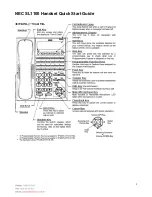
44
Chapter 3: Helmet Maintenance
Touch-up
This procedure will not restore the original appearance of the polyurethane paint. The original
appearance can only be restored by re-coating the entire painted surface after a repair is made.
Perform the touch-up as follows:
1. Remove the visor assembly and the oxygen mask.
2. Clean the affected area with a cloth dampened in aliphatic naphtha.
3. Using a paint brush, apply polyurethane paint only to the damaged area.
Repair
1. Hand-sand the damage area of the helmet shell with wet 320 grit sandpaper, feathering
chipped and cracked edges.
2. Clean the affected area with a cloth dampened in aliphatic naphtha.
3.
Fill the affected area with epoxy filler putty and allow to dry overnight. Filler putty may be
applied with a putty knife, squeegee, or other suitable applicator.
4.
Sand the filled area with sandpaper until it is level with the helmet shell.
5. Repeat Steps 3 and 4 until the repair is level and smooth.
NOTE:
When accessory components are removed and relocated, unused holes in the helmet
shell may be filled by using epoxy kit NSN 8040-00-753-4800.
Refinishing
1. When a repair has been completed, rough-sand the entire helmet shell with 320 grit
sandpaper. This step is intended to prepare the shell to accept a finishing coat of
polyurethane paint. It is not desirable or necessary to remove the epoxy primer paint.
2. Clean the entire painted surface with cloth dampened in aliphatic naphtha.
3. Mask all external components, edgeroll, and helmet opening.
4. Spray-paint only the repaired area with one coat of epoxy primer paint. Allow to cure for 8
hours at 21 degrees Celsius (70 degrees Fahrenheit).
5. Spray-paint one coat of polyurethane paint over the entire helmet shell. This coat is an
anchor coat and should be applied thinly. Allow to cure for 15 minutes.
6.
Spray-paint a finish (wet) coat of polyurethane. Allow to cure at for 24 hours at 21 degrees
Celsius (70 degrees Fahrenheit).
















































